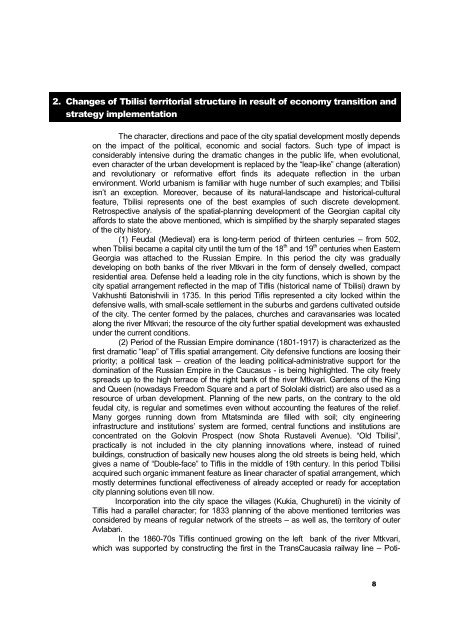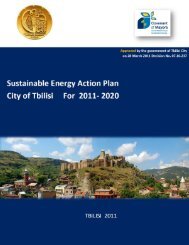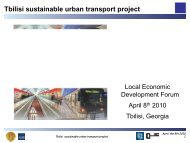LOCAL ECONOMIC DEVELOPMENT PLAN FOR TBILISI ... - LED
LOCAL ECONOMIC DEVELOPMENT PLAN FOR TBILISI ... - LED
LOCAL ECONOMIC DEVELOPMENT PLAN FOR TBILISI ... - LED
Create successful ePaper yourself
Turn your PDF publications into a flip-book with our unique Google optimized e-Paper software.
2. Changes of Tbilisi territorial structure in result of economy transition and<br />
strategy implementation<br />
The character, directions and pace of the city spatial development mostly depends<br />
on the impact of the political, economic and social factors. Such type of impact is<br />
considerably intensive during the dramatic changes in the public life, when evolutional,<br />
even character of the urban development is replaced by the “leap-like” change (alteration)<br />
and revolutionary or reformative effort finds its adequate reflection in the urban<br />
environment. World urbanism is familiar with huge number of such examples; and Tbilisi<br />
isn’t an exception. Moreover, because of its natural-landscape and historical-cultural<br />
feature, Tbilisi represents one of the best examples of such discrete development.<br />
Retrospective analysis of the spatial-planning development of the Georgian capital city<br />
affords to state the above mentioned, which is simplified by the sharply separated stages<br />
of the city history.<br />
(1) Feudal (Medieval) era is long-term period of thirteen centuries – from 502,<br />
when Tbilisi became a capital city until the turn of the 18 th and 19 th centuries when Eastern<br />
Georgia was attached to the Russian Empire. In this period the city was gradually<br />
developing on both banks of the river Mtkvari in the form of densely dwelled, compact<br />
residential area. Defense held a leading role in the city functions, which is shown by the<br />
city spatial arrangement reflected in the map of Tiflis (historical name of Tbilisi) drawn by<br />
Vakhushti Batonishvili in 1735. In this period Tiflis represented a city locked within the<br />
defensive walls, with small-scale settlement in the suburbs and gardens cultivated outside<br />
of the city. The center formed by the palaces, churches and caravansaries was located<br />
along the river Mtkvari; the resource of the city further spatial development was exhausted<br />
under the current conditions.<br />
(2) Period of the Russian Empire dominance (1801-1917) is characterized as the<br />
first dramatic “leap” of Tiflis spatial arrangement. City defensive functions are loosing their<br />
priority; a political task – creation of the leading political-administrative support for the<br />
domination of the Russian Empire in the Caucasus - is being highlighted. The city freely<br />
spreads up to the high terrace of the right bank of the river Mtkvari. Gardens of the King<br />
and Queen (nowadays Freedom Square and a part of Sololaki district) are also used as a<br />
resource of urban development. Planning of the new parts, on the contrary to the old<br />
feudal city, is regular and sometimes even without accounting the features of the relief.<br />
Many gorges running down from Mtatsminda are filled with soil; city engineering<br />
infrastructure and institutions’ system are formed, central functions and institutions are<br />
concentrated on the Golovin Prospect (now Shota Rustaveli Avenue). “Old Tbilisi”,<br />
practically is not included in the city planning innovations where, instead of ruined<br />
buildings, construction of basically new houses along the old streets is being held, which<br />
gives a name of “Double-face” to Tiflis in the middle of 19th century. In this period Tbilisi<br />
acquired such organic immanent feature as linear character of spatial arrangement, which<br />
mostly determines functional effectiveness of already accepted or ready for acceptation<br />
city planning solutions even till now.<br />
Incorporation into the city space the villages (Kukia, Chughureti) in the vicinity of<br />
Tiflis had a parallel character; for 1833 planning of the above mentioned territories was<br />
considered by means of regular network of the streets – as well as, the territory of outer<br />
Avlabari.<br />
In the 1860-70s Tiflis continued growing on the left bank of the river Mtkvari,<br />
which was supported by constructing the first in the TransCaucasia railway line – Poti-<br />
8
















